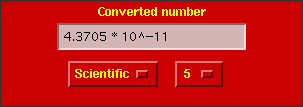Help
What the converter can do
-
If you know a quantity in a certain unit A, the converter can transform
it into any other unit B, provided you enter A and B
correctly, and A, B are compatible units. (See however, the Adapt function.)
-
If you know a quantity in a certain unit A, and you want it to be
expressed in some standard system of units, such as CGS, atomic units, ..., but
you don't know precisely what form the target unit B takes in that
system of units, the converter will provide the unit B automatically.
-
If you don't know what is the unit A of a quantity, but you can express
it in term of physical constants such as c, q, h..., the
converter will compute the unit A from these constants.
-
If you want to convert an energy into a wavelength, say, but you don't know
which formula should be used, the function
Adapt will provide this formula.
-
If the input unit A you enter corresponds to a certain dimension (mass,
velocity, conductance...), the converter will indicate this dimension in the
right-hand side fields.
-
If you use the temperature units "oC" (Celsius or
Centigrade) or "oF" (Fahrenheit), the converter will take
into account the shift in the zeros of these temperature scales, provided the
unit you have typed has the dimension of temperature, and "oC" or "oF" are not mixed with other
units.
What the converter can not do
-
If the number you want to convert is expressed in some system of units, for
example the atomic units, but you don't know exactly what is the dimension of
this quantity (a length, a time, an energy...), the converter will not be able
to guess this information and convert the number into another system of units.
-
The converter will not display in output fields units like
"N" (Newton),
"C" (Coulomb), or
"T" (Tesla), since these units can be expressed
in terms of fundamental units. Instead, the Newton will be written as
"m kg s^-2", the Coulomb will be
"s A", and the Tesla will be
"kg s^-2 A^-1" (if you use the
International system).
-
The converter can't handle fractional powers of the units such as
"m^(2/3)".
|






